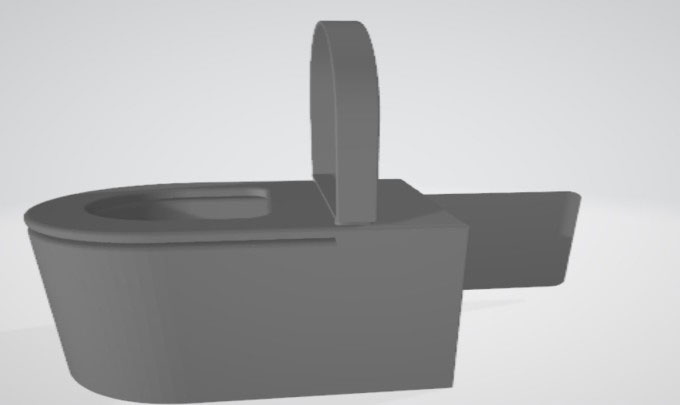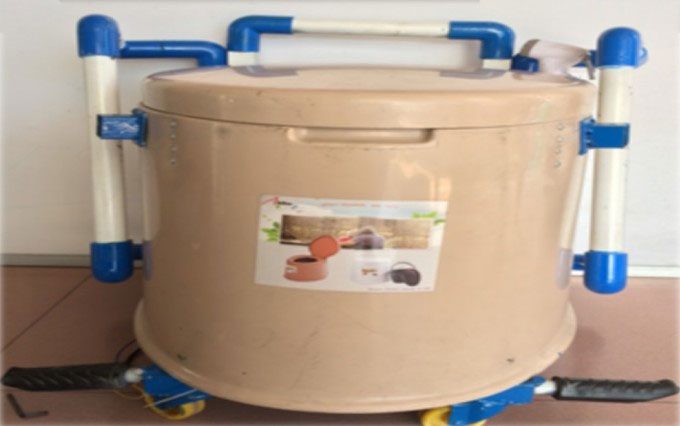A group of students from Da Nang University of Science and Technology has developed a smart toilet with integrated sensors to monitor users’ health while in use.
The product was created by Tran Van Phuc and Cao Thi Thuy Hang, students majoring in Electrical Engineering, with the aim of providing safer toilet experiences for the elderly and those with health issues.
The toilet is designed with plastic materials, weighs under 1 kg, and is easy to carry and move. The base of the toilet is equipped with a biodegradable plastic waste bag. A UV light installed on the toilet lid serves to kill bacteria on the surface and reduce odors during use. The UV light’s intensity is adjusted to ensure it does not harm human skin. An infrared sensor is also designed so that when the lid is opened, the light turns off, and when the lid is closed, the light turns back on.
To enhance the product’s intelligence, Phuc has integrated heart rate, temperature, and blood oxygen level sensors in the lid area. These sensors will transmit health data to a smartphone via a free application, allowing family members to monitor their loved ones’ health status. The parameters are highly accurate and easily managed on a mobile device, making it simple to update information. “In rural areas, people often pay little attention to these indicators. However, these health metrics are quite important for assessing a patient’s condition,” Phuc stated.

3D design image of the smart toilet developed by the team. (Photo: NVCC)
Phuc shared that he conceived this product idea after witnessing the difficulties his father faced due to chronic gout, especially when it came to personal hygiene. Often, his father had to endure pain just to use the toilet, which was very challenging. Phuc aspired to create a smart toilet that would be convenient for users to avoid moving and also reduce odors. He nurtured this idea since high school, but it wasn’t until he entered university and gained specialized knowledge that he began to implement it. On days without classes, Phuc dedicated time to designing the toilet on his computer and programming to integrate smart features. After about four months, the product was successfully developed by the team.
Regarding the product’s uniqueness, Cao Thi Thuy Hang, a team member, noted that there are currently many similar products on the market priced between 250,000 and 2.5 million VND. However, most of these products lack health monitoring features and do not include a UV light system for sterilization and odor reduction. This product is useful for elderly and mobile patients, while those who are bedridden and unable to maintain personal hygiene will still require assistance.

The actual product of the first version of the smart toilet. (Photo: NVCC)
Currently, Phuc is testing the product with family members and has received feedback that it is easy to use and odor-free. In the near future, the research team plans to develop an automatic waste disposal mechanism to facilitate cleaning for family members. After perfecting the technology, the team intends to collaborate with hospitals and nursing homes to test the product on a larger scale to evaluate its effectiveness and adjust it to meet needs.
Phuc mentioned that the estimated cost to produce one smart toilet is around one million VND, making it affordable for the majority of the population.
According to Master Vu Tuan Anh, Deputy General Director of Dr.SME Consulting and Digital Transformation Company, the smart toilet project is promising as it can be easily produced domestically with a design made from plastic shells, integrating sensors and hardware components to enhance the product’s features.
However, to bring the product to market, Mr. Tuan Anh believes the team needs to develop software solutions capable of analyzing health data and automatically alerting family members. Additionally, the project requires a business partner to provide hardware solutions and support the production of the toilet.
“I believe this is a practical project suitable for development in the domestic market to meet the needs of the elderly and patients in the next 5-10 years,” Mr. Tuan Anh remarked.


















































